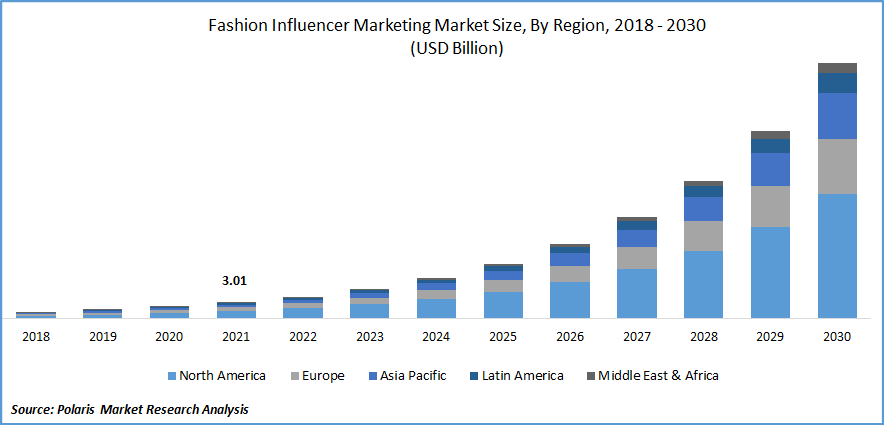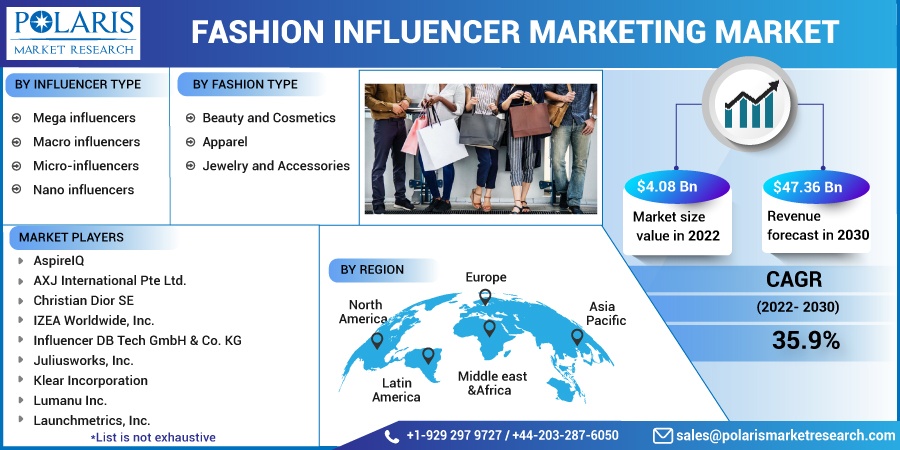
Fashion Influencer Marketing Market Share, Size, Trends, Industry Analysis Report
By Influencer Type (Mega influencers, Macro influencers, Micro-influencers, and Nano influencers); By Fashion Type; By Region; Segment Forecast, 2022-2030
- Published Date:Dec-2022
- Pages: 115
- Format: PDF
- Report ID: PM2903
- Base Year: 2021
- Historical Data: 2018-2020
Report Outlook
The global fashion influencer marketing market was valued at USD 3.01 billion in 2021 and is expected to grow at a CAGR of 35.9% during the forecast period.
The marketing of fashion-related products and clothes on online social media platforms is known as "fashion influencer marketing." Fashion influencers are professionals and everyday people with a committed social media following who post information about fashion and promote clothing, cosmetics, jewelry, fashion shows, and other brands on their networks. The goal of fashion influencer marketing is to create organic dialogues about the business and its products by providing subscribers and followers with relevant material. Research and discovery, program and influencer customer engagement, analytics and reporting, workflow automation, and fraud detection services are just a few of the marketing services that the network operators provide.

Know more about this report: Request for sample pages
Retail entertainment websites are encouraging visitors to interact, comment on, and buy the products being marketed in real-time by using digital payment tools, live streaming, and shopping areas. In January 2019, the debut of IZEAx Discovery has been announced by IZEA Worldwide, Inc. The innovative platform gives marketers accessibility to influencer search profiles as well as VizSearch, IZEA's distinctive content discovery tool. Marketers can join up and pay with a credit card on izea.com for the standalone function IZEAx Discovery, which costs USD 149 per month. Fashion firms can broaden their recognition among consumers and sell their products in more creative ways that are consistent with their core values by utilizing influencers.
In addition, it is projected that rapid urbanization and rising internet penetration, particularly in developing nations, will fuel market growth. Urbanization in emerging markets frequently moves employees from agricultural or informal jobs into a more formal working setting. Not every employee wears a suit and tie to work, but they might need to be dressed a certain way depending on their workplace. Urbanization is also linked to a rise in consumer sophistication, which raises the demand that consumers will become brand-aware about their purchases.
Easy access and reasonable internet connections give customers a new way to communicate with target markets, driving the development of influencer marketing tactics. These marketing techniques can assist companies and brands in developing more focused advertising campaigns that will enhance customer connections and revenue. Thus, the rising urbanization and internet usage strategies have increased the demand for fashion apparel and cosmetics in the market which has impacted the growth of fashion influencer marketing.
Additionally, companies used the COVID-19 closure to their advantage by increasing brand awareness online. An organization's goods and services are shown to potential clients by enhancing and maintaining a brand's internet presence. Companies also ethically market their goods and use "cause-related marketing" to benefit society. Brands create social responsibility initiatives that are acceptable and might work during COVID situations.
 Know more about this report: Request for sample pages
Know more about this report: Request for sample pages
Industry Dynamics
Growth Drivers
One of the main elements contributing to the market's optimistic view is the fashion industry's rapid rise, which coincides with the global proliferation of social media platforms. The usage of social media has expanded the power of fashion influencers, and it is anticipated that fashion firms want more fashion influencer marketing. For this kind of marketing across the globe, social media platforms such as Facebook, YouTube, Pinterest, and Instagram are excellent choices.
To adapt and tap into new market opportunities, fashion firms have been urged to employ fashion influencer marketing methods due to the high presence of social media sites among millennials, such as Facebook and Instagram. Among millennials, Instagram is incredibly popular, and influencers are using it to promote fashion firms.
Moreover, companies have been able to invest in marketing campaigns more effectively and see a higher return on investment (ROI) as a result of technological disruption in advertising methods and marketing tactics. In July 2019, Brand Access Manager, a new tool from AspireIQ, is the first to enable businesses to easily convert branded content into paid adverts on Facebook and Instagram.
For many brands, allocating advertising funds to influencer marketing initiatives has proven to be a successful tactic for doubling down on the most fruitful influencer and creator collaborations and producing quantifiable outcomes. Fashion firms are starting to see a higher return on investment and more effective marketing campaigns as a result of investing in fashion influencers. Influencer marketing for fashion firms is becoming increasingly beneficial due to the rising use of social media platforms globally. This factor is anticipated to further fuel market expansion in the near future.
Report Segmentation
The market is primarily segmented based on influencer type, fashion type, and region.
|
By Influencer Type |
By Fashion Type |
By Region |
|
|
|
Know more about this report: Request for sample pages
The micro-Influencer segment is expected to witness the fastest growth
Nano-influencers are less adaptable than micro-influencers, who have more followers. Fashion brands can better research the demographics of their customers owing to their larger following. Due to their greater flexibility when working with brands than macro and mega influencers, the micro-influencer segment is expected to increase its revenue share over the forecasted period. Micro-influencers provide immediate marketing of a business's goods or services with high discussion rates. This enables them to design and produce better products and content. Fashion firms can enhance their reputation among consumers and foster positive customer relationships by utilizing marketing strategies that include fashion influencers.
The beauty and Cosmetics segment industry accounted for the highest market share in 2021
The beauty and cosmetics segment is growing due to the rising attention of beauty and cosmetics companies for paying to use social media platforms to create a favorable brand image and boost sales. People increasingly look to influencers to offer the best advice through promotional videos or makeup tutorials because the cosmetics they choose are frequently influenced by their preferences for skin type and skin tone. The promotional and instructional videos posted by influencers help their audience better grasp the products.
The demand in North America is expected to witness significant growth
The region dominates the market for fashion influencer marketing as a result of the significant usage of social media and the accessibility of high-speed internet in the area. Because a sizable portion of North American users is in the 18 to 34 age range, fashion firms may reach a wider audience. Furthermore, sponsored postings must now be identified as such according to the American Federal Trade Commission (FTC). It provides more thorough insights into the effectiveness of marketing campaigns and brand awareness, which helps control market expansion.
The expansion of the market is also being fueled by the rising popularity of AD-blocking software and the importance of influencers to affiliate marketing networks. Due to the presence of numerous prominent luxury fashion brands in the region, Europe attracted a sizeable revenue share. Additionally, the area hosts several fashion weeks, which aids influencers in showcasing their attire and accessories. Additionally, the existence of a sizable blogging culture in the Nordics that aids influencers in showcasing their material via blogs are anticipated to boost market expansion.
Competitive Insight
Some of the major players operating in the global market include AspireIQ, AXJ International, Christian Dior, IZEA Worldwide, Influencer DB Tech, Juliusworks, Inc., Klear Incorporation, Lumanu, Launchmetrics, Mavrck Corp, Quotient Technology, ScrunchSocial Beat Digital Marketing, Speakr, Inc., The SMC Group, Upfluence, and Yves Saint Laurent.
Recent Developments
In November 2020, PARKLU, China's top influencer analytics platform, has been acquired by Launchmetrics. This is the business's second purchase this year (the first was IMAXtree).
Fashion Influencer Marketing Market Report Scope
|
Report Attributes |
Details |
|
Market size value in 2022 |
USD 4.08 billion |
|
Revenue forecast in 2030 |
USD 47.36 billion |
|
CAGR |
35.9% from 2022 - 2030 |
|
Base year |
2021 |
|
Historical data |
2018 - 2020 |
|
Forecast period |
2022 - 2030 |
|
Quantitative units |
Revenue in USD billion and CAGR from 2022 to 2030 |
|
Segments Covered |
By Influencer Type, By Fashion Type, By Region |
|
Regional scope |
North America, Europe, Asia Pacific, Latin America; Middle East & Africa |
|
Key Companies |
AspireIQ, AXJ International Pte Ltd., Christian Dior SE, IZEA Worldwide, Inc., Influencer DB Tech GmbH & Co. KG, Juliusworks, Inc., Klear Incorporation, Lumanu Inc., Launchmetrics, Inc., Mavrck Corp, Quotient Technology Inc, ScrunchSocial Beat Digital Marketing LLP, Speakr, Inc., The SMC Group, Upfluence, Inc., Inc., and Yves Saint Laurent SAS |
